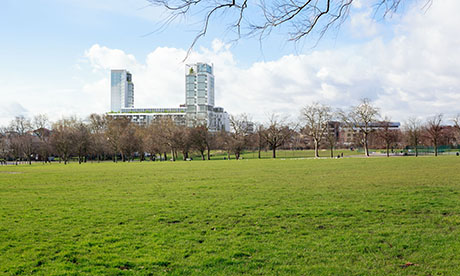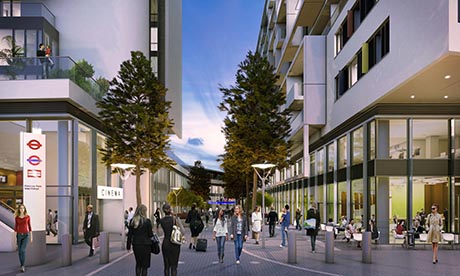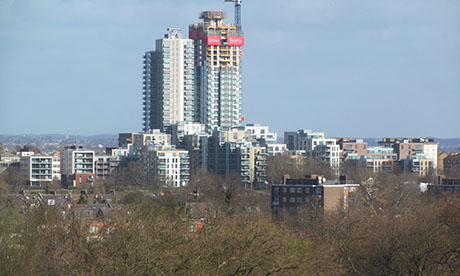Facelifts meet resistance as developers begin ‘intensification’ of Finsbury Park
Finsbury Park has been a byword for many things. Established as a genteel suburb in the 1860s following construction of the Great Northern Railway, the streets surrounding the eponymous park were built up with handsome houses for the rising middle classes. Over the course of the 20th century, successive waves of immigrant communities made Finsbury Park their home, attracted by convenient transport links and the open spaces of the park itself.
Greek Cypriots were followed by Bengalis and Irish, and in the 1990s increasing numbers of Algerians, Ethiopians and Somalis. In the early years of the new century, the Finsbury Park Mosque became notorious as a haven of religious radicals, preached to by Egyptian cleric Abu Hamza.
The mosque was eventually returned to community use, but other problems remained, including the chronic anti-social behaviour that has long eluded police in this neighbourhood split between the boroughs of Hackney, Islington and Haringey. Prostitution plagues Brownswood Road, drug-dealing takes place inside the park gates, and match-day rowdiness is a regular occurrence in the streets and the pubs closest to Emirates Stadium. With each local authority keen to shift problems away, they have festered.
To compound the area’s complications, Haringey Council has in recent years sought to extract increasing amounts of revenue from the 110-acre green space at its centre. Bob Dylan, the Arctic Monkeys and several dollops of gay Pride have brought welcome business to local traders, but they have also generated noise, crowds and effluent.
A series of facelifts have given Finsbury Park periodic injections of micro-regeneration – a makeover of the station façade in 2005-6, the opening of City and Islington College in 2005 and Park Theatre in 2013. Yet none of these nips and tucks has been sufficient to alter the general feeling of seediness that pervades the area around the station. The dripping undersides of two pigeon-beloved railway bridges, the surge of traffic and the heaving crowds make most who alight here seek a quick exit.
A stone’s throw away to the north and south lie tree-lined Victorian streets, hip cafés, vintage furniture shops and green space. The open acres of Finsbury Park itself and the rural nooks of Gillespie Park are both on the station’s doorstep, while Clissold Park, the West Reservoir, the Greenway and Highbury Fields are all within easy walking distance. Not surprisingly, estate agents abound. This little corner on the outer edges of inner London may have its problems, but it is a functional suburb nonetheless.
What many locals agree is that the neighbourhood does not need the thrusting rejuvenation afforded by skyscrapers. Yet their arrival is imminent, thanks to the efforts of planners at Islington, Haringey and Hackney councils.
A ‘City North’ complex, to be completed in 2018 following two years of construction and station-entrance closures, will include two 21-storey towers atop a retail complex housing a cinema and a supermarket. The structure will loom over the north-eastern side of the railway station, with its feet in Fonthill Road, a side street off Seven Sisters Road. Only 47 of the 355 flats will be classed as ‘affordable’, of which 28 (8 per cent of the total) will be social rented.
If developers have their way, City North will be followed soon after by a seventeen-storey complex to replace the Rowans Tenpin Bowl building on Stroud Green Road. The landmark edifice, a familiar site to those travelling north out of King’s Cross station, was the subject of a 5,000-signature petition to Haringey council last March, yet even this broad-based local movement failed to halt the proposals.
Meanwhile just off the eastern reaches of Finsbury Park, new plans for the redevelopment of Woodberry Down estate entail squeezing 5,000 flats into space previously designated for 4,500, and inhabited by 2,000 prior to regeneration of the site. The Berkeley-Homes-built scheme includes the Residence, a 27-storey tower block whose crane-topped profile can be seen from Clissold Park as well as from Finsbury Park itself. A new 30-storey ‘Skyline’ tower, to be completed on Woodberry Down in 2017, features three-bed flats on sale for £1,117,500.
At a 21 February meeting, organised by local regeneration charity Finsbury Park Trust to discuss development of the area, the addition of tower blocs was described by planning expert Eric Sorensen as bringing ‘intensification’ to an area. Examples he cited of previous successful ‘intensification’ were Barking town centre and Canary Wharf.
But for many local residents, Finsbury Park is already ‘intense’ enough. The audience at the event came out strongly in favour of keeping the current look of the area, including the Rowans bowling site where the meeting took place. Repeated objections to the developments were met with loud applause as the community vented its frustration.
Stephen Coles, Vicar of St Thomas’s Church, voiced concern that “having two 21-storey towers would be setting some kind of precedent that others could point to”.
Chris Evans, owner of Blighty Café on Blackstock Road, told the Citizen: “I am worried that the tall buildings will look out of place and give us a similar look to Archway or Croydon with tall high rises blighting the skyline”.
Hackney councilor Brian Bell, who represents Brownswood Ward on the south side of the park, suggested to the Citizen that the critical views of those at the event did not represent local feeling on the issue of high-rise towers, as ‘others not at the meeting’ were happy for the blocks to go up.
Nevertheless it is clear that there is considerable unease among many residents at the prospect of this Victorian rail hub giving way to plate glass. Unfortunately for them, tall buildings look set to transform Finsbury Park very soon.
Note: this article was amended at 6.25pm Thursday 16 April 2015. The statement, ‘What many locals agree is that the neighbourhood does not need the thrusting rejuvenation afforded by skyscrapers’ had previously stated ‘most’ rather than ‘many’.



